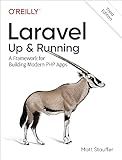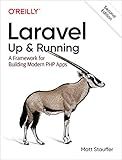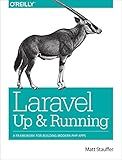Best Laravel Development Guides to Buy in December 2025

Laravel: Up & Running: A Framework for Building Modern PHP Apps



Laravel: Up & Running: A Framework for Building Modern PHP Apps



Ultimate Laravel for Modern Web Development: Build Robust and Interactive Enterprise-Grade Web Apps using Laravel's MVC, Authentication, APIs, and Cloud Deployment (English Edition)



Architecture of complex web applications. Second Edition.: With examples in Laravel(PHP)



Laravel: Up and Running: A Framework for Building Modern PHP Apps



Practical Laravel: Develop clean MVC web applications


To make a POST request in Laravel, you can follow these steps:
- Create a route in your Laravel application that listens to the POST method. You can define routes in the routes/web.php or routes/api.php file.
- In your route definition, specify the URL to which the POST request will be made. For example, if you want to make a POST request to /submit-form, you can use Route::post('/submit-form', [ControllerName::class, 'methodName']);.
- Create a controller file or use an existing one, which will handle the logic for the POST request. In the above route example, ControllerName refers to the name of your controller file, and methodName refers to the specific method within that controller that will handle the request.
- Inside the designated controller method, you can access the request data using the $request parameter. Laravel automatically injects an instance of the Illuminate\Http\Request class into controller methods.
- Use the $request object to access the POST data. For example, you can retrieve form input values with $request->input('field_name') or get all form inputs at once with $request->all().
- Perform any necessary validation or business logic on the retrieved data.
- You can then return a response using Laravel's response methods like response()->json() or response()->redirect(), depending on your application's requirements.
- If necessary, update your views or frontend code to send the POST request to the defined URL, typically using HTML forms or JavaScript AJAX calls.
Remember to take care of validation, authorization, and other security considerations as per your application's needs.
How to handle errors during data validation in Laravel post requests?
In Laravel, you can handle errors during data validation in post requests by following these steps:
- Create a validation request class using the artisan command: php artisan make:request MyRequest This will generate a new request class in the app/Http/Requests directory.
- Open the newly created request class (MyRequest.php) and define the validation rules in the rules method. For example:
public function rules() { return [ 'name' => 'required|string|max:255', 'email' => 'required|email|unique:users,email', // add more validation rules as needed ]; }
- In your controller method that handles the post request, type-hint the request with your custom request class:
use App\Http\Requests\MyRequest;
public function store(MyRequest $request) { // validation passed, continue with processing data }
- If the validation fails, Laravel will automatically redirect the user back to the previous page with the validation errors. You can display these errors in your blade template using the @error directive. For example:
- Additionally, you can customize the error messages by overriding the messages method in your request class. For example:
public function messages() { return [ 'name.required' => 'The name field is required.', 'email.required' => 'The email field is required.' ]; }
By following these steps, you can handle errors during data validation in Laravel post requests and provide a good user experience by displaying meaningful error messages.
What is the purpose of a post request in Laravel?
The purpose of a POST request in Laravel, as in any other web development framework, is to send data to the server to create or update a resource. It is used when you want to send data from the client-side to the server-side, such as submitting a form, creating a new record in a database, or updating an existing record.
In Laravel, you can define routes to handle POST requests and specify the corresponding controller and method to handle the request. The data sent in the request payload can be accessed and processed within the controller's method, allowing you to perform various actions like storing the data in a database, updating records, sending emails, or performing any other necessary operations based on the POST request data.
How to handle redirects after a successful post request in Laravel?
In Laravel, handling redirects after a successful POST request can be done using the redirect() method provided by the framework. Here's how you can handle redirects after a successful POST request in Laravel:
- Inside your controller method that processes the POST request, you can perform the necessary actions such as storing data, updating records, etc.
- After the successful processing of the request, you can use the redirect() function to redirect the user to the desired page. For example:
public function store(Request $request) { // Process the POST request, store data, update records, etc.
// Redirect the user to a specific route
return redirect()->route('route.name');
// Redirect the user to a specific URL
return redirect('https://example.com');
// Redirect the user back to the previous page
return redirect()->back();
}
- In the redirect() method, you can use the route() function to redirect to a specific named route or pass a URL directly.
- Additionally, you can use the ->with() method to attach session flash data to the redirect. This flash data will be available on the redirected page. For example:
return redirect()->route('route.name')->with('success', 'Data has been saved successfully!');
- On the redirected page, you can check for the flash data using the session() helper or Session facade. For example:
@if(session('success')) {{ session('success') }} @endif
By following these steps, you can handle redirects after a successful POST request in Laravel and provide meaningful feedback to the user.
What is the use of the redirect function in Laravel post requests?
The redirect function in Laravel's post requests is used to redirect the user to a different URI after the form is submitted. It allows you to redirect the user to a different page, route, or URL after the form data is successfully processed.
When a user submits a form via a post request, the server processes the form data, performs necessary actions, and then returns a response. In some cases, it is desired to redirect the user to a different page instead of returning a direct response.
The redirect function in Laravel simplifies this process by allowing you to simply specify the URI where you want to redirect the user. For example, you can redirect the user to a specific route name, a named route, or a URL.
Here's an example of how the redirect function can be used in a post request:
public function store(Request $request) { // Process and validate the form data
// Redirect the user to a different page
return redirect()->route('dashboard');
}
In this example, the user will be redirected to the 'dashboard' route after the form is successfully processed.
What is the use of the post method in Laravel?
The POST method in Laravel is used to send data securely to the server and perform a designated action on that data, such as creating a new resource, updating an existing resource, or executing a specific functionality. It is commonly used for form submissions where sensitive data, such as login credentials or payment information, needs to be sent securely to the server.
When using the POST method in Laravel, the data is sent in the HTTP request body, rather than in the URL like in the GET method. This provides security advantages as the data is not visible in the URL and is encrypted.
In Laravel, the POST method is typically utilized in web applications to handle form submissions, AJAX requests, and any other actions that require data to be sent to the server for processing or manipulation. It is a fundamental method in web development for creating, updating, and processing data on the server side.
How to handle a post request in Laravel?
To handle a POST request in Laravel, you can follow the steps below:
- Define a route in the routes/web.php or routes/api.php file that points to the corresponding controller method. For example: Route::post('/your-url', 'YourController@yourMethod');
- Create a new controller (if not already there) using the following command: php artisan make:controller YourController
- Open the generated YourController.php file and add the method yourMethod with the logic to handle the POST request. For example: input('name'); // Process the data or perform any other actions as required return response()->json(['status' => 'success']); } }
- In the yourMethod method, you can access the form data or input values sent in the POST request using the $request parameter.
- After processing the request, you can return a response. In the example above, a JSON response is returned using the response()->json() method, but you can return any valid response type based on your application's requirements.
That's it! With these steps, you can handle a POST request in Laravel.
